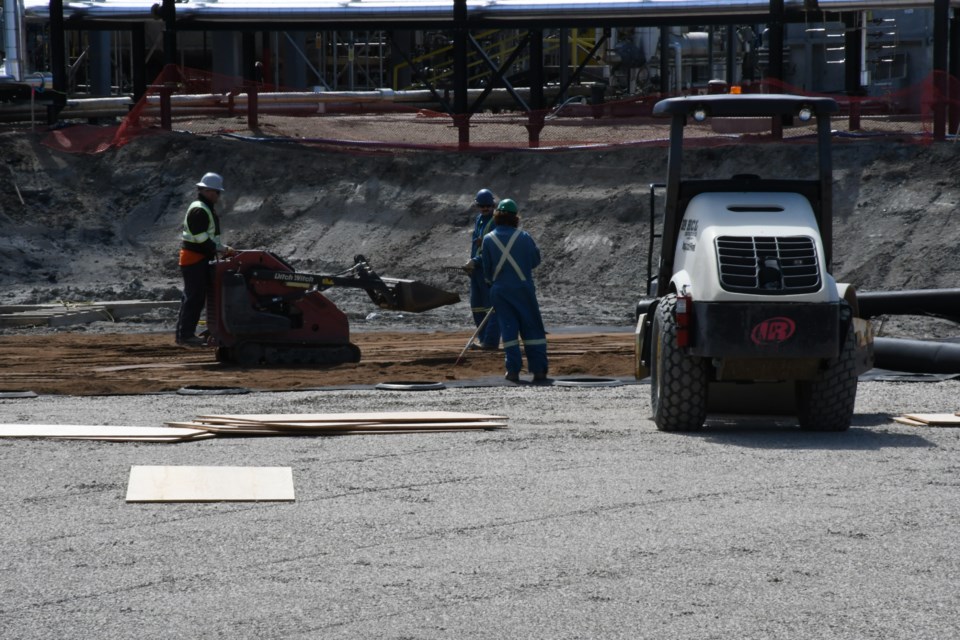Gibson Energy spent tens of millions of dollars in 2022 to upgrade its Moose Jaw refinery and increase storage capacity, which included constructing a 70-foot-tall oil tank that can hold 175,000 barrels.
The company conducts annual turnarounds at the 88-year-old venue to ensure operations continue safely and with integrity.
Last year, the four-week spring turnaround allowed the organization to clean, inspect, upgrade and construct equipment, according to a sustainability report. Some inspections focused on the heat exchangers, the crude oil tower, the vacuum tower, the electrical systems, the boiler and piping.
The company also serviced all the pumps and installed new seals.
To expand capacity, reduce greenhouse gas emissions and improve operational efficiency, Gibson Energy completed construction of a natural gas liquids (NGL) plant and switched from a feedstock-based, higher emissions intensity fuel supply to natural gas, the report continued.
These upgrades increased the refinery’s overall production capacity and throughput by about 25 per cent, or 22,000 barrels per day (bpd). They also added a new saleable product stream by capturing a byproduct of the NGL production process that would otherwise be burned up.
The upgrades — which cleared up system bottlenecks — will also see the refinery reduce its flaring, leading to less nitrogen oxide, methane and sulphur oxide emissions of roughly 5,000 tonnes per year, the report added.
The venue is a heavy crude oil processing centre that produces various high-quality refined products such as oil, roofing flux and road asphalt.
The refinery was constructed in 1935 and produced 7,500 barrels of oil per day (bopd) before eventually increasing to 23,500 bopd. Since purchasing the venue in 2003, Gibson Energy has increased storage to roughly 1.4 million barrels, with 750,000 barrels in crude oil and the rest for other liquid products.
During the last 20 years, the company has attempted to determine how it can make the refinery run better, faster, stronger and safer, explained Sean Wilson, chief administrative and sustainability officer, during a phone interview.
Many pieces are from 1935, so the company has sought to upgrade the venue often, he continued. Furthermore, most storage tanks have a lifespan of 40 to 75 years, so those also need to be upgraded or replaced.
The smallest on-site tanks can hold 25,000 barrels and are 20 feet high, while the largest tanks — near Chateau St. Michael — hold 200,000 barrels and are 80 feet high.
“We want to continue to grow that facility. It’s an important part of our strategy going forward from a business perspective,” Wilson said. “We need more room. The tank is important because we’re pushing more barrels through (the refinery). … We (also) need a place to store the output before we put it on the rails.”
It’s typical to see large crude oil refineries temporarily shut down every year so crews can check on equipment, similar to an annual vehicle or health inspection, he continued.
The upgrades — which included 54 employees and hundreds of local and provincial tradesmen — ensure the company does not have to shut down the venue annually for turnarounds. Instead, it will be every three years.
“It’s pretty labour intensive when you shut down the facility,” said Wilson, adding nearby homeowners will likely be pleased that the next shutdown occurs in 2025 because it usually features plenty of truck traffic, noise and dust.
Federal regulations state that companies must check all storage tanks every five to 10 years, which makes such an activity “a big housekeeping exercise,” Wilson remarked. However, Gibson Energy will use every opportunity to expand storage to ensure the venue functions smoothly.
Another infrastructure project the company pursued was adding stairs to the smaller tanks adjacent to the Manitoba Expressway. This will allow employees to access the roof hatches to look inside if maintenance issues arise.
“(The refinery is) a lifelong asset for Gibson Energy … ,” Wilson added. “It’s an important part of our fabric, as is Moose Jaw. We want to be a good neighbour and appreciate the opportunity to do business in your community.”




